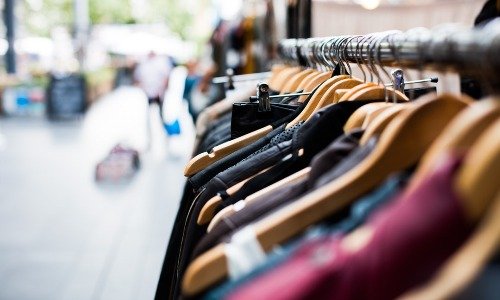When choosing your travel clothes it is important to consider everything from material to fit. Travel clothing should also be able to work for multiple trips and in your day to day life. Being a frugal person and a minimalist means our list for what we look for in travel clothes gets very specific. The means we are picky, which is a privilege.
Here are the essential questions we ask before buying travel clothes.

Travel clothes material
- Is it non-wrinkle/breathable?
- Does it have quick dry technology?
The material is at the top because it determines most of the other pieces. We buy lighter pieces that are breathable, even if headed to cold climates. We can just layer on top of each other to get the desired warmth. This layer method is ideal for hiking especially.
Our favorite materials are Merino Wool, Linen, Fleece and Cotton.
Travel clothes durability
- Is it made well?
- Will it last for more than 5 trips?
- If it rips or tears can I return it?
Durability often comes down to price. Typically if you pay a bit more- you will also have a more durable item. However, you can always second-hand (E-Bay or Thrift) some of the brands that provide durability. Most outdoor companies offer a repair service that can be free (product marked as a defect) or a small charge to fix the item.
Companies that we love who offer the ultimate durability protection are Patagonia, Darn Tuff Socks (our Fav!) and Outdoor Research. These companies make products to last a lifetime if not at least half and have no problem saying so.
Travel clothes sustainability
- Is it ethically made?
- Is it a part of fast fashion?
- If it is, is it second-hand?
This is always a tough one. Most clothing is not truly ethically made, even if the label states that it was. Due to farming practices and the damage that it does to our earth and to the unfair labor conditions around the world for factory workers, clothing that is truly sustainable and ethically made can be hard to find.
Additionally, I often hear criticism if I am writing that I packed an H & M shirt. The fact is, I bought that shirt when money was a different concept for me and much harder to find. So judgement on this is always a double edged sword. I will not be tossing out my whole wardrobe to start over, but only be aware for all of my next purchases because I can. We certainly have pieces we bought awhile ago that were not ethically made, yet if we threw them out they would be sitting in a landfill contributing to another problem.
We use the following websites to check out companies we like:
Where to buy clothing that meets our long list of demands for travel wear and is sustainable is always a hunt. However we have:
- Bought clothing from small unknown companies or companies run by women. Small companies, does not mean the product will not work for you.
- Bought second hand
- Bought online using E-bay etc.
Our best recommendation is using the website https://www.geartrade.com/ You can find items from REI or whatever piece you are looking for. They are owned by Backcountry and have most of Backcountry’s returns as well. You can also sell your own gear.
A company I recently found that has a great fit for me and is both sustainable and ethical is Toad & Co. Sold at REI and of course online.

Travel clothes fit
- Will this be able to work if I gain or drop a few pounds?
- Is this flattering?
- Does this cover what it needs to?
Fit is important for comfort. If it does not fit it will not be comfortable. We try to find things that are stretchy and forgiving. That way if I am bloated or if one of us ate too much the night before we do not have to squeeze into something. Fit is a personal preference, but our goal is to be comfortable going from a night out to hike a mountain and making sure the fit will work for either.
Transitions and Function
- Will this be able to work for life and for travel?
- Can I wear this to work or on the weekends too?
- Does this work more than one way in multiple settings?
As minimalists, we prefer not to have multiple wardrobes and keep it simple. HisFI has more of a minimalist wardrobe than myself, yet we still keep it pretty paired down. This means for us, our travel clothes need to work for our day to day life.
We need to be able to wear them to work and day. This means when we shop we are conscious about the items function. It must function in more than one way. For example, a shirt needs to be able to be worn to work, but also serve another purpose such as wearing it for a hike. This sounds a bit impossible but it is not. Most pieces can be dressed up or dressed down with a scarf or just the shoes. HisFI’s pants go from rugged looking to dressy with the swap of his foot wear. For more on his pants check out his ultimate travel gear packing list here.
Style
- Will this go with everything? Is it a mix and match piece?
- Is this a classic cut or style instead of a trendy piece?
When we shifted out wardrobes we chose neutral palette that will go with everything. This means we each own lots of black, navy and gray. HisFI’s color pallet is jewel tones for shirts and mine is stripes, plain colors with structured cuts and the occasional pop of leopard print.
We no longer shop for any trendy items or bold prints because we have found our color palettes that work for us. This means if I walk into a store I can head straight to a specific color instead of browsing and looking at everything. Saves me time and money.
A Few Tips:

Wear them first!
Do not start your trip with new travel clothes that have not had a good test run- yes, I mean more than the try-on room. I will typically take them out for a hike or a day trip just to make sure everything feels rights. Ideally you could wear them most places anyways and they become your wardrobe.
If travel clothes do not work out or you are sick of them because you wore it for two weeks:
- look into return options
- give them to another friend who travels
- Pack it away and bring it out next season
Do not pack travel clothes that are falling apart!
I cannot tell you how many times I have packed a pair of worn out sandals and ended up throwing them out after one or two days. Travel is harder on clothes so make sure they are top notch.
Use packing cubes:
Save space and stay organized by using packing cubes. We only do one bag travel now and these have becomes essentials for us. Do not forget to have one designated for the stinky clothes as they get dirty.
For more on how we pack in one bag and travel for free check out this category of posts.
This post may contain affiliate links. If you click and make a purchase, we receive a small commission at no cost to you! For more information, read our full disclaimer.



